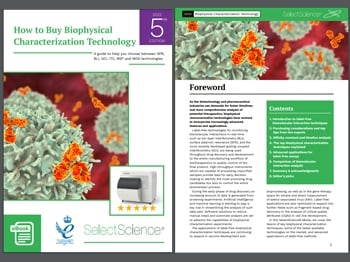Biophysical characterization technology is becoming increasingly important in the biotechnology and pharmaceutical industries. Label-free assays are being used throughout drug discovery and development, as well as in the entire manufacturing workflow of biotherapeutics, including quality control of the final product. Common biophysical interaction techniques include surface plasmon resonance (SPR), bio-layer interferometry (BLI), isothermal titration calorimetry (ITC), microscale thermophoresis (MST), microfluidic diffusional sizing (MDS), and grating-coupled interferometry (GCI). When selecting the right biophysical characterization technology, it is important to keep in mind the principles of flexibility, cost, and ease of use to ensure that you make the best investment for your research. Scientists should evaluate cost and ease of use when purchasing equipment. The cost evaluation must include operating costs such as consumables and maintenance, in addition to the initial purchase price. The system features must be evaluated for efficiency, and the software must be intuitive to benefit every buyer.
A Guide to Biophysical Characterization Technology
Biophysical characterization technology is becoming increasingly important in the biotechnology and pharmaceutical industries. As demand for more comprehensive analysis of potential therapeutics increases, these instruments have evolved to incorporate increasingly advanced features that reduce manual steps and increase sensitivity for a range of applications. In this free SelectScience eBook, you can learn about the basics of key biophysical characterization techniques, some of the latest available technologies on the market, and advanced applications of label-free methods. You’ll also find tips on how to determine the best biophysical characterization technology for your research.
Label-free assays are being used throughout drug discovery and development, as well as in the entire manufacturing workflow of biotherapeutics, including quality control of the final product. Biophysical characterization technologies measure molecular binding without the use of labels and can provide data in real time. These assays provide a precise and efficient approach for collecting a wide range of information related to the interaction of the biomolecules used, such as concentration, biosimilarity, specificity, potency, and selectivity of the molecular binding, which lead to higher workflow efficiencies.
Common biophysical interaction techniques include surface plasmon resonance (SPR), bio-layer interferometry (BLI), isothermal titration calorimetry (ITC), microscale thermophoresis (MST), microfluidic diffusional sizing (MDS), and grating-coupled interferometry (GCI).
When selecting the right biophysical characterization technology, there are three overarching principles to keep in mind: flexibility, cost, and ease of use. As the field and your research advances, you do not want to invest in a system that has limited applications and sample scope. Several years in, will you be able to upgrade throughput? Run an experiment based on other molecule combinations? Combine your system or transfer the same sample to another technique?
In conclusion, biophysical characterization technology is a powerful tool that can provide in-depth characterization of the interactions of molecules. Label-free assays can help in drug discovery and biotherapeutics by measuring molecular binding without the use of labels and providing data in real time. Common biophysical interaction techniques include SPR, BLI, ITC, MST, MDS, and GCI. When selecting the right biophysical characterization technology, it is important to keep in mind the principles of flexibility, cost, and ease of use to ensure that you make the best investment for your research.
A Guide to Buying Biophysical Characterization Technology
When purchasing biophysical characterization technology, it’s important to keep in mind the cost and ease of use of the system. Scientists know that capital for equipment is hard to come by, and purchasing decisions must be well thought out. When evaluating cost, operating costs such as consumables and maintenance are equally as important as the initial purchase price.
In addition, keep efficiency in mind as you evaluate system features. Some features, such as intuitive software, benefit nearly every buyer. But you may not need other features that will instead slow you down and limit the number of people that can use the instrument.
To learn more about the top biophysical characterization techniques, their advantages and drawbacks, along with expert insight on some of the available technologies, and advanced applications for label-free assays, download the free eBook How to Buy Biophysical Characterization Technology.
Don’t miss interesting posts on Famousbio

